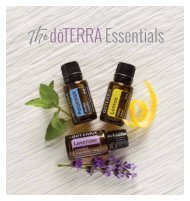doTERRA European Living Magazine Summer 2018
This is the Summer 2018 of the European doTERRA magazine. Feel free to browse at leisure to appreciate the great work that this Company is doing to help farmers and communities where the plants that produce Certified Pure Therapeutic Grade Essential Oils are grown and how these Oils and many other natural products are assisting so many people with symptoms of poor health and to assist with preventative health care. For further information or to get access to these products watch our 3 introductory videos at www.showmedetails.net or text/call +447970494774. Thank You. David Miller
This is the Summer 2018 of the European doTERRA magazine. Feel free to browse at leisure to appreciate the great work that this Company is doing to help farmers and communities where the plants that produce Certified Pure Therapeutic Grade Essential Oils are grown and how these Oils and many other natural products are assisting so many people with symptoms of poor health and to assist with preventative health care. For further information or to get access to these products watch our 3 introductory videos at www.showmedetails.net or text/call +447970494774. Thank You. David Miller
You also want an ePaper? Increase the reach of your titles
YUMPU automatically turns print PDFs into web optimized ePapers that Google loves.
DR. DAVID K. HILL, DC<br />
Executive Vice President, Chief<br />
Medical Officer/Chairman, Scientific<br />
Advisory Committee<br />
Does temperature<br />
affect my oils?<br />
Once opened, excessive or increasing heat is known to intensify the reaction rate leading<br />
to oxidation and polymerisation of essential oils. Oxidation alters the chemical make-up of<br />
essential oils, converting the chemical constituents into different substances, changing the<br />
aroma, diminishing the beneficial properties, and possibly even increasing the<br />
risk for sensitivities. Essential oils are all chemically unique, so the oxidation<br />
process begins at different temperatures, occurs at varying rates, and affects<br />
each oil distinctly, but never are the effects positive. Cold temperatures, on the<br />
other hand, generally do not induce chemical changes in the oil, even at freezing<br />
temperatures. Properly storing essential oils can prolong their useful life. For<br />
best results, I recommend that all essential oils be kept away from direct sources<br />
of heat and under 25 degrees Celsius.<br />
What resources<br />
are available for<br />
me to learn how I<br />
can expand my use<br />
of essential oils for<br />
self-care?<br />
There are two distinct components to expanding your functional knowledge<br />
of essential oils: research and experience. We are all distinct in how we react to exogenous<br />
input. Despite the science, you may have better (or worse, or simply different) experiences<br />
with specific oils than others. So use them and develop your own model of daily use based<br />
upon your experiences. At dōTERRA, we are proud to be the science leaders in the essential<br />
oil industry and we’ve created some amazing educational and usage tools, such as the Oil<br />
Chemistry Wheel. Soon we will be releasing a major expansion of the wheel, which will be the<br />
ultimate essential oil user’s guide. Keep checking the dōTERRA Science Blog (doterra.com/<br />
US/en/blog-science) for further information.<br />
What is the<br />
process of creating<br />
an essential oil<br />
blend?<br />
The process of bringing an essential oil blend from an idea to market is a long and complex one.<br />
The backbone of dōTERRA essential oil blends is chemistry and the synergism of the chemical<br />
constituents that provide the wonderful benefits. Blends are first imagined based<br />
on meeting a precise chemical profile to address a specific concern. Since<br />
dōTERRA only works with whole oils and does not isolate chemical constituents,<br />
that initial profile is met by selecting individual oils and then deciding on the<br />
overall composition. Then tests can be conducted to ensure that the chemical<br />
constituents and their proportions are not altered by the blending process. Once<br />
the desired chemical composition has been established, other considerations<br />
such as scent can be addressed through further revision. Only after several<br />
stages of testing and revision, making sure that it meets CPTG standards, does a<br />
blend idea become a dōTERRA essential oil.<br />
4 / EUROPE LIVING MAGAZINE




